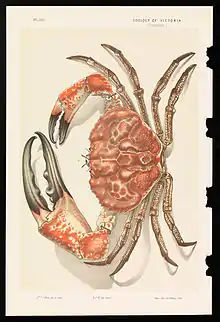John James Wild
John James Wild (born Jean Jacques Wild; 1824 – 3 June 1900) was a Swiss linguist, oceanographer and a natural history illustrator and lithographer, whose images were noted for their precision and clarity. He participated in the Challenger expedition of 1872–76. In 1881 he emigrated to Australia, where he contributed to Frederick McCoy's Prodromus of the Zoology of Victoria.[1]
Detailed biography
Wild was born in Zurich, Switzerland, in 1824.
Wild met his wife, Elizabeth Ellen Mullin, while teaching languages in Belfast, Ireland.[1]
Wild joined the 1872–1876 Challenger expedition as official artist and secretary. This expedition, carried out by the Royal Society, spent four years surveying the oceans. Equipped with a dark room aboard HMS Challenger, photographers were able to develop and print images soon after they were taken. This expedition is thought to have been the first to make use of photography as well as the services of an artist. Wild's contribution to the expedition's reports was Thalassa, An Essay on the Depth, Temperature and Currents of the Ocean, and for which he received an honorary doctorate from the University of Zurich. He also wrote and illustrated a book on the expedition, At Anchor, a Narrative of Experiences Afloat and Ashore During the Voyage of H.M.S. "Challenger" from 1872 to 1876. 'Wild Islet' in the D'Entrecasteaux Islands is named after John James Wild.[2]

Wild emigrated to Melbourne, Australia, in 1881. Having been turned down repeatedly by New Zealand in his quest for work, he managed to eke out a living in Melbourne by giving lectures in modern languages and literature at Trinity College, supplemented by acting as matriculation examiner in French and German, and moonlighting as secretary and artist.
As he had with Frederick Schoenfeld and Arthur Bartholomew, Frederick McCoy quickly appreciated Wild's potential to contribute to his Prodromus of the Zoology of Victoria, and Wild's most important Australian legacy was this work he carried out for McCoy. His skill in producing accurate images was also noticed by Walter Baldwin Spencer, Professor of Biology at Melbourne University, who became Director of the National Museum, and who commissioned Wild to illustrate the Giant Gippsland Earthworm for the Philosophical Society in 1888. In the same year Wild delivered the inaugural lecture on Anthropology at the Australasian Association for the Advancement of Science in Sydney.
He died in Prahran, Victoria in 1900.[3]
Wild Knoll in Antarctica is named after John James Wild.
External links
| Wikimedia Commons has media related to John James Wild. |
References
- "John James Wild". Caught & Coloured: Zoological Illustrations from Colonial Victoria. Museum Victoria.
- Rose, Roger G. "A historic Admiralty Islands kapkap, and some ethnological implications". Journal of the Polynesian Society. 89 (2): 247.
- "John James Wild: Considerable Achievements". Caught & Coloured: Zoological Illustrations from Colonial Victoria. Museum Victoria.
